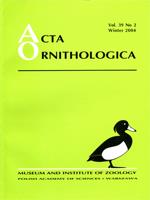The biology of individually colour-ringed European Blackbirds inhabiting two city parks in Szczecin (NW Poland) was studied in 1997–2003. In each park one to three observers watched the behaviour of Blackbirds every other day from dawn till afternoon (6–8 h a day); in this way almost all of their nests were discovered. 35 cases were recorded where pairs re-used their own nests, as well as two cases where the nest of another Blackbird pair and one Fieldfare nest were re-used. In 33 out of 81 cases observed, the re-use occurred after the brood had been successfully reared, while in two cases out of 378, female Blackbirds initiated the second breeding attempt in the same nest after the loss of the first one. The re-used nests were better concealed (80 ± 19% and 69 ± 18%, respectively) and had been built at greater heights than those abandoned after breeding (9.0 ± 5.0 m and 6.5 ± 4.2 m, respectively). No shortening of the interval between successive clutches was noted in the case of nest re-use (re-used nests 36.8 ± 4.9 days, newly-built nests 37.7 ± 8.0). The more and more frequent re-use of nests where breeding had been successful, their better concealment and higher sites, and also the lack of any differences in the intervals between successive clutches of pairs occupying old nests and those building new ones before the next breeding attempt, suggest that in the investigated population the basic reason for nest re-use was the insufficient number of safe nesting sites.
How to translate text using browser tools
1 December 2004
Nest Re-Use by Blackbirds — The Way for Safe Breeding?
Dariusz Wysocki
A. Antonov
,
D. Atanasova
2003. Re-use of old nests versus the construction of new ones in the Magpie Pica pica in the city of Sofia (Bulgaria). Acta Ornithol. 38: 1–4. Google Scholar
R. F. Bawtree
1952. Blackbirds nest in use six times in three successive seasons. Brit. Birds 45: 330. Google Scholar
C. R. Blem
,
L. B. Blem
,
L. S. Berlinghoff
1999. Old nests in Prothonotary Warbler nest boxes: Effects on reproductive performance. J. Field Ornithol. 70: 95–100. Google Scholar
J. V. Briskie
,
S. G. Sealy
1988. Nest re-use and egg burial in the Least Flycatcher, Empidonax minimus.
Can. Field. Nat. 102: 729–731. Google Scholar
J. F. Cavitt
,
A. T. Paerse
,
T. A. Miller
1999. Brown Thrasher nest reuse: a timing saving resource, protection from search-strategy predators, or cues for nest-site selection? Condor 101: 859–862. Google Scholar
E. Cohen
1952. Blackbird using a Song-Thrush's nest of the same season. Brit. Birds 45: 367. Google Scholar
W. Cresswell
1997. Nest predation: The relative effects of nest characteristics, clutch size and parental behaviour. Anim. Behav. 53: 93–103. Google Scholar
D. R. Curson
,
Ch. B. Goguen
,
N. E. Mathews
1996. Nest-site reuse in the Western Wood-pewee. Wilson Bull. 108: 378–380. Google Scholar
W. J. Eckerman
,
L. D. Beletsky
,
G. H. Orians
,
T. Johnsen
,
S. Sharbaugh
,
C. D'Antonio
1990. Old nests as a cues for nesting-site selection: an experimental test with Red-winged Blackbirds. Condor 92: 113–117. Google Scholar
A. Gregoire
,
S. Garnier
,
N. Dreano
,
B. Faivre
2003. Nest predation in Blackbirds (Turdus merula) and the influence of nest characteristics. Ornis Fennica 80: 1–10. Google Scholar
M. Hotta
1994. Infanticide in little swifts taking over costly nests. Anim. Behav. 47: 491–93. Google Scholar
D. Lack
,
W. Light
1950. Blackbirds using old nests and the same nest site in successive seasons. Brit. Birds 43: 404. Google Scholar
C. Lindell
1996. Patterns of nest usurpation: when should species converge on nest niches? Condor 98: 464–473. Google Scholar
F. de Lope
,
A. P. Møller
1993. Effects of ectoparasites on reproduction of their swallow hosts: a cost of being multibrooded. Oikos 67: 557–562. Google Scholar
E. Ludvig
,
L. Vanicsek
,
J. Török
,
T. Csörgö
1995. The effect of nest-hight on the seasonal pattern of breeding success in blackbirds Turdus merula.
Ardea 83: 411–118. Google Scholar
T. E. Martin
1992. Interaction of nest predation and food limitation in reproductive strategies. Current Ornithol. 9: 163–197. Google Scholar
H. C. A. McBride
1978. Repeated re-use of a nest by a blackbird. Bird Study 25: 188. Google Scholar
A. P. Møller
1994. Parasites as an environmental component of reproduction in birds as exemplified by the Swallow Hirundo rustica.
Ardea 82: 161–172. Google Scholar
I. Newton
1994. The role of nest sites in limiting the number of hole-nesting birds: a review. Biol. Conserv. 70: 265–276. Google Scholar
L. J. Rhodes
,
C. W. Bush
1955. Blackbird rearing four broods in same nest. Brit. Birds 48: 93–94. Google Scholar
W. M. Shields
1984. Fractors affecting nest and site fidelity in Adirondack barn swallows. Auk 101: 780–789. Google Scholar
B. Stephan
1985. Die Amsel. Neue Brehm-Bucherei 95, Ziensen, Wittenberg Lutherstadt. Google Scholar
L. Tomiałojć
1994. Breeding ecology of the Blackbird Turdus merula studied in the primaeval forest of Białowieża (Poland). Part 2. Reproduction and mortality. Acta Ornithol. 29: 101–121. Google Scholar
B. D. Watts
1987. Old nest accumulation as a possible protection mechanism against search-strategy predators. Anim. Behav. 35: 1566–1568. Google Scholar
H. P. Weeks
1978. Clutch size variation in the eastern phoebe in Southern Indiana. Auk 95: 656–666. Google Scholar
D. Wysocki
2004. Age structure of urban population of Blackbird (Turdus merula) in Szczecin (NW Poland). Zoologica Poloniae, in press. Google Scholar
D. Wysocki
,
J. Adamowicz
,
R. Kościów
,
P. Śmietana
2004. Breeding territory in urban population of European blackbird Turdus merula.
Ornis Fennica 81: 1–12. Google Scholar

Acta Ornithologica
Vol. 39 • No. 2
December 2004
Vol. 39 • No. 2
December 2004
Blackbird
nest re-use
predation
predator avoidance
Turdus merula




